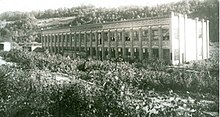Twyford Motor Car Company
The machine used connecting rods, like locomotives, and had the same design as a Park Trap, which gave it the appearance of a light, horse-drawn carriage.
The patent drawings show an automobile with a complicated arrangement of gears and shafts that provided a crude form of four-wheel drive and power-steering.
The name, Stanhope, refers to an archaic car body style that used a single bench seat, and a folding cloth top.
The 17th September issue of Horseless Age has the company located at 5920 Penn Avenue in Pittsburgh and having a new gasoline automobile coming out soon.
Two investors, E. A. Carmalt and Strong, agreed to help provide financial backing, under the condition that he relocate to Brookville, Pennsylvania.
[5] In May 1904, Robert E. Twyford claimed, that after developing a prototype for five years, he now had an automobile that would run over rough and muddy roads and allow any member of a family to drive it safely.
The decline in the lumber industry, which Brookville had relied on before then, meant that the community needed to find new sources of revenue.
The company had raised $25,000 in capital stock and named the following men as directors: R. E. Twyford, A. D. Deemer, H. C. Beach, D. L. Taylor, E. A. Carmalt, C. A. French, W. N. Humphrey, W. N. Vanleer and W. D. Shields, with A. D. Deemer acting as president, W. N. Humphrey as vice president, R. E. Twyford as general manager and D. L. Taylor as secretary and treasurer.
[7] The directors organized the company under Delaware Corporate law, and had capital stock of $500,000, with $200,000 of that offered for sale at $50.00 per share.
[8] According to the local press, the Twyford automobile had four-wheel drive, which allowed it to climb steep grades, and travel through mud, snow and unpaved roads.
The Twyford's axles consisted of solid steel, with no knuckle joints, which gave the car strength and durability.
The Twyford especially attracted the interest of the medical practitioners because most of them traveled to patients’ homes over often poorly maintained roads.
J. M. Yadkin, manager of Adams Express Company, Mr. Henry A. Kamman, a pork and beef packer, and H. C. Gardner, a milk dealer, all admired the machine.
George Willaofer, who had two brothers working as doctors, liked the four-wheel drive, because it would allow the machine to travel through sand, or even off-road.
After this experience, the board of directors of the Twyford Company wanted to buy more machinery, hire more men, and even build a new factory.
If he had attended the larger shows, like in New York City, Philadelphia, Chicago and Boston, and able to fill orders there also, the company could have made $562,500.
In taking his car to Washington, where all the skilled men and attorneys were at the patent office, Robert Twyford knew he had the best invention.
[15] Robert Twyford, to demonstrate the pulling power of the cars, on July 12, 1905, drove a 9 hp runabout down Main Street in Brookville.
As shown in Figure 6, he fitted the rear-wheels to a wooden frame, using castors, which showed that he could drive the car with only the front-wheels.
A reporter observed Robert Twyford driving the car through town and allowing several Brookville citizens to ride in it.
[17] In December, 1905, rumors of false reports concerning the merits of the Twyford still circulated, even though the company presented a new car "of rich, artistic design.
Most likely, the crudeness of the Twyford's four-wheel drive and experimental two-cycle engine proved riskier than the company's directors realized.
In 1905, Otto Zachow and William Besserdich invented a four-wheel drive system, encased in a drop-forged ball, utilizing a lockable center differential with a double-Y universal joint that operated at the juncture of the front wheel and axle for steering.
[25] But, no one actually used the former Twyford factory until the Union Auto Specialties Company, founded by James M. Humphrey Jr., moved in around 1913.
Using the Twyford patent, they founded the Commercial Motor Car Company in San Antonio and Houston, Texas in 1912.
[28] Robert Twyford had his patent renewed in 1915, as shown in Figure 10, but apparently no longer tried building four-wheel drive vehicles.
[31]In 1985, William McCracken, a retired mechanic at the time living in Richardsville, Pennsylvania, began building a replica of the original Twyford, "because there weren't any".
Although he had several offers from museums to exhibit the car, he instead planned to the donate it to the Jefferson County History Center in Brookville, Pennsylvania.
In November 2005, volunteer workers moved the Twyford replica into the museum at the Jefferson County History Center, in Brookville, Pennsylvania.
Figure 11 shows the Twyford replica on display at its permanent home in the main first floor of Parker Gallery.










